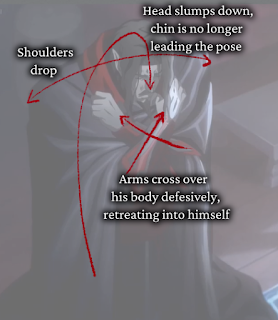Character Analysis (DAA200CA- Acting)
VLAD DRACULA TEPES
(Netflix's Castlevania)
Gender: Male
Age: Immortal
Ethnicity: White (?)
Family: Lisa Tepes (Wife), Adrian "Alucard" Tepes (Son)
Cultural background: Wealthy
Intelligence (IQ): High
Education: Scholarly
Occupation: Vampire Lord and King of the Undead
Religion/Philosophy: No religious ties
Sexual orientation: Straight (?)
Goals, ambition, dreams: To destroy humanity, and to orchestrate the end of the world
Secrets: We wishes to die
Fears/Phobias: None, as he has nothing left to lose
Sense of humor: Non-existent, though he does humor his wife and laugh at her jokes and behavior
Adrenaline moments: When he declares war on humanity for the murder of his wife
Physical description: A tall, imposing man, garbed in a long cape. Square-framed shoulders with still movements, never needing to move so much as one unnecessary inch. Healthy, yet terrifying.
Physical disabilities, if any: None
What makes a character interesting?
Dracula is both the most dangerous threat of the story of Castlevania, but in this version most of all, Dracula's passion is used as an antagonistic tool more than his other iterations. Dracula's love for his late wife both fuels the conflict of the story as intensely as it resolves it towards the end of Season 2, as Dracula's love for his wife, and ultimately his son, drives his actions.
SyncSketch Link
Character Poses and Gesture:
 |
| Primary Posture of Dracula |
Dracula's primary pose. It appears simple, but the way his back is always straightened and stiff, with his chest forward and chin out-facing, emphasized his status, regality, and his ability to impose dominance in any situation.
 |
Breakdown #1
|
 |
Dracula vs. Alucard
|
Dracula's rage, another staple of his character. Even in combat, he lords over his enemies, striking poses and stances that accentuate his large frame and strength. Every stance he takes in battle is meant to show the audience how powerful he is.
 |
| Breakdown #2 |
 |
| Dracula's shame |
The rare sight of Dracula in a moment of weakness. The softer side of Dracula is typically only seen in flashbacks when he is with is wife, and here we see it when he realizes the value of his own son's life. Through gesture, we see a man who is broken, alone, and ashamed. This side of Dracula, more than any other, is the emotional anchor behind his genocidal and cruel actions.
 |
| Breakdown #3 |
Intention
(Links to an external site.)
What is the message or emotion you are communicating in the scene? What are your choices?
Dracula fully intends to kill his son, Alucard, in this scene, seeing him in another obstacle on his path to genocide. However, in the end, it's the love for his son and his mother that allow Dracula to not only spare Alucard, but to allow his own death wish to be fulfilled.
Subtext (Links to an external site.)
The implicit meaning of a character or scene. Body acting and speech could contrast each other.
Dracula's death is the cumulation of his desire to die and finally be with this wife, even though he wanted to bring all of humanity down on the way out. Instead, he accepts that the man his wife fell in love with no longer exists, and that there is nothing left for him than to be with her and accept his demise.
Specificity (Links to an external site.)
Knowing your character, conveying the intent in a way that is unique to them.
Throughout both seasons up to this point, most of the central characters suspect that Dracula's impractical plan to wipe out humanity is secretly a plea for help, an admission of a lack of willingness to continue living. We see that when Dracula attacks his own son, though instead of killing him outright, he pummels him slowly and meticulously. His actions and the validated suspicions of the other characters both catch up with him during is final moments with his son.
Execution (Links to an external site.)
Posing, Arcs, Polish, Mechanics
I can not think of many more well done moments of animation in season 2 than this. Dracula's punches carry a sickening heft and weight to them, and Alucard's staggering movements show that he is trying and failing to keep up with his father. Dracula doesn't wait for his son to get back up before delivering blow after blow. However, when they enter Alucard's childhood room, Dracula goes from a stoic, battle-ready stance, so a softer, pleading pose. His hands stay clasped over his heart for much of the scene, his voice cracks and wavers, and he leans on the surroundings as if he's trying and failing to put himself back together. He stares at the hands that have laid hands on his son, and we can see he's ashamed. Even when he is staked by his own son, his body implies pain without the anger or fear. It's just death, which is what he has been secretly waiting for.
Caricature (Links to an external site.)
Exaggerate to communicate and simplify the action
"I'm killing my boy. Lisa... I'm killing our boy."
"Your greatest gift to me... and I'm killing him."
Dracula has a very eloquent and dramatic manner of speech, both which are utilized perfectly to sell the sorrow of the scene.

















